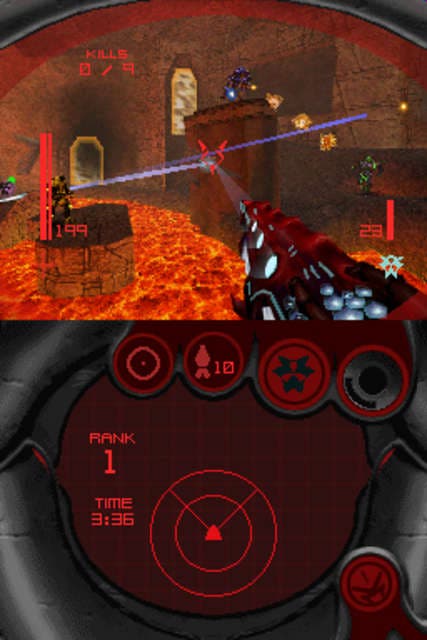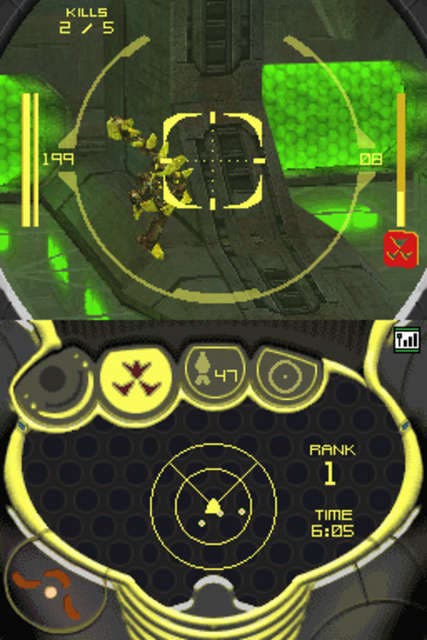Metroid Prime: Hunters
Hunt it down.
WARNING - Repetitive Motion Injuries
Playing videogames can make your muscles and joints hurt after a few hours. Follow these instructions to avoid problems such as tendonitis and carpal tunnel syndrome.
- Avoid excessive play.
- Take a 10 to 15 minute break every hour, even if you don't think you need it.
- If your hands, wrists or arms become tired or sore while playing, stop and rest them for several hours before playing again.
- If you continue you have sore hands, wrists or arms, during or after play, stop playing and see a doctor.
Like everyone else who owns a Nintendo DS, I don't bother to re-read this, part of the Health and Safety booklet included with every Nintendo title, each time I start up the system, though it warns me to. I skip past it as quickly as possible to get to my current game of choice.
Players of my current game of choice, Nintendo's new first-person shooter Metroid Prime: Hunters, would do very well to listen to the advice and actually bother to read the flimsy pamphlet included in the case, specifically the part I've paraphrased above. Because I've been playing Metroid Prime: Hunters solidly since I got my hands on it, and my arms and wrists feel like they're being gripped by the claws of an angry lobster god as payback for brethren once boiled.
On one hand, teeth gritted through the pain, I couldn't stop playing. On the other hand, which actually feels like it's hanging off, for the love of god take some breaks.
Controller Controller

Despite what I've just written, in theory my preferred control system of Metroid Prime: Hunters isn't that bad, and it works tremendously well in practice, other than the searing pain. With (thankfully) options for both left- and right-handed players, right-handed players can choose to play in Stylus Mode, with the stylus used to control aiming and the d-pad to control movement, or with Dual Mode, aiming controlled with the d-pad, and movement controlled with the buttons. In both cases the left-handed option is a simple switch of sides. Gamers who are accustomed to a slightly different control method (such as the GoldenEye method) are sadly left out of the equation, as within the four control types there is absolutely no space for customisation, other than the sensitivity or to invert the X/Y axis.
It's likely however that most players will happily settle in one of the available modes. Stylus Mode offers superior accuracy at the cost of pain, though the controls can be made a smidge more comfortable with use of the thumbstrap. Dual Mode is comfortable, but does seem to suffer a hit in accuracy akin to switching from using a mouse and keyboard to just using a keyboard - online, I would expect skilled players could still manage to play well with this mode but to this humble reviewer it certainly does seem likely that stylus players will quickly dominate... The repetitive strain injury ward of your local hospital.
A Prime Adventure

The single-player Adventure Mode initially feels like a very linear, out of character quest to collect the eight Octoliths left by an ancient race in the Alimbic cluster. With Samus beginning the game with a full compliment of abilities, and the first three or so Octoliths collectable from distinctly separate 'levels' without a single spot of backtracking or exploration, it would be easy to feel terribly disappointed - were it not far easier to be seduced by the absolutely astounding graphics. Metroid Prime: Hunters looks better than any other full 3D title I've seen on the system, and arguably is leagues ahead even the nicest looking titles available on the PlayStation or N64. While never quite reaching the heights of its GameCube siblings, it does reveal how effectively Nintendo Software Technology has managed to exploit the power of the DS.
The Adventure Mode manages to dispel any initial disappointment by the time the initial wonder of the graphics begins to wear off, with previously unexplored sections of visited planets revealed through the judicious use of one of Samus' new range of weapons, from the Magmaul (bit like a grenade launcher) to the Imperialist (bit like a sniper rifle). While the bosses are perhaps one of the game's greatest disappointments (there are really only two, which alternate and increase in difficulty, for each octolith) the challenges faced during the level, from opposing bounty hunters, offer a far more interesting experience. Each encounter is an intense deathmatch, serving as a good introduction to each bounty hunter and to the multiplayer experience. The mode does suffer by only allowing the player to save on the ship, requiring some lengthy (often danger-filled) backtracking to save at points, which is far less than ideal on the move.
However, Metroid Prime: Hunters offers a superb and challenging single-player mode that stands up well in every respect to the predecessors in the series.
How to make friends and influence rivals?

The multiplayer mode is surprisingly much more of a mixed bag. Using Nintendo's near-flawless Wi-Fi system, you can be up and playing within a matter of seconds, but the system really isn't designed for playing against random players. Only one mode is available (vanilla deathmatch) set to first-to-seven-kills with a time limit of seven minutes. Levels are selected by each player choosing a level and the majority vote winning. On top of this limitation, characters and levels must be unlocked through the story mode or through time spent playing on Wi-Fi, severely decreasing the options available for players who just want to dive right in.
Limitations aside, Metroid Prime: Hunters makes a quite enjoyable deathmatch game. Surprisingly similar to Quake III, gameplay is fast and furious, with an unforgiving requirement on accuracy and speed. Levels are largely designed as arenas or with clear flashpoints, and can veer from far too small (Combat Hall is a massacre with a full compliment of four players) to way too large, which makes selecting 'random' as your choice of level a true gamble.
Metroid Prime: Hunters feels like a game that rewards skill rather than luck, and while it is still early days yet for the online experience, personal choice rules character and weapon selection. While playing as Samus initially seems to be a weak decision in the face of the seductive new powers of the other hunters, her ability to drop bombs as a morph ball is an excellent defensive move if you've bitten off more than you can chew and need to run. And while Weavel's alt-form, an automatic turret, if cleverly placed can happily mow down opponents, it does leave the player almost completely defenceless as little more than a pair of legs. Even the weapons selection is as open-ended, with the standard power beam as valuable as any other weapon with its good chance for a deadly headshot and rapid fire.

The multiplayer mode is, as typical for Nintendo, entirely geared to the experience of playing with friends. Once you have a populated friends list, rather than search for a random game, you can enter the 'Friends and Rivals' lobby, in which you can select from any games currently about to start, or host your own game, and select from the full gamut of options. A remarkable seven multiplayer modes are available, including capture the flag and king of the hill variants.
While more esoteric demands cannot be met using the system, such as requiring all players go the same character, they can be negotiated using the astounding voice chat system. Working somewhat like a walkie-talkie, holding down X allows you to transmit to the other players in the pre- and post-game stages. It works remarkably well, and as it's only available to friends it means that you can quite easily keep testosterone-addled teenage boys from screaming obscenities, unless all your friends are testosterone-addled teenage boys I guess. To ease the pain of a small friends list, the game also allows you to set players met through random matches as 'rivals', who can be invited to Friends and Rivals games. The game also features Rivals Mode, which is a bit like Nintendogs' Bark Mode, which will pick up, and add to your DS, the details of any player in your local Wi-Fi range also in rivals mode. Much like Bark Mode, however, this is likely to be less than useful to anyone who doesn't happen to live in Tokyo.
Multi-card local multiplayer is just as well featured as online, and includes the apparently secret ability to include (remarkably competent) bots in the matches, which allows you to get some sneaky offline practice in, with wins counting in your win/lose ratio! Single-card local multiplayer offers only battle mode, but does at least allow the host player to set the win conditions.
Metroid Prime: Hunters is not a life-changing experience (if you discount the coming years of physiotherapy on my arms) but it is an astoundingly competent first-person shooter. While the multiplayer mode is a flimsy experience unless you have friends you can rely on, the single-player mode offers a worthy adventure even for players who don't ever expect to take the game online.


